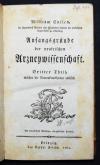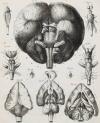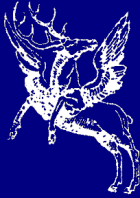Neurologie
Die Liste enthält 4 Einträge. Suchergebnisse löschen und Gesamtbestand anzeigen.
| Abbildung |
Beschreibung Gesamte Buchaufnahme |
Preis EUR |
|
|---|---|---|---|
 |
Cullen, William. Anfangsgründe der praktischen Arzneywissenschaft. Dritter Theil, welcher die Nervenkrankheiten enthält. (Nach der vierten englischen Ausgabe übersetzt und mit Anmerkungen und Zusätzen vermehret von Christian Erhard Kapp). Leipzig, Carpar Fritsch 1784. 8°. [3] Bl., 336 S. mit Titelvignette in Holzschnitt. Halblederband der Zeit mit Rückenschild.
Hirsch/Hüb. II, 153. VD18 90384172. Vgl. Waller 2234 u. Garrison-Morton 4920.1. – Erste deutsche Ausgabe des in sich abgeschlossenen dritten Teils von Cullens Hauptwerk. – Mit einem Anhang „Von den Mitteln, ertrunkene und dem Anschein nach todte Personen wiederherzustellen“. – Zeitgenöss. Besitzvermerk, Deckel unten mit Fehlstellen am Bezugspapier, durchgehend etwas braunfleckig, gutes Exemplar. Schlagwörter: Neurologie, Neurology |
100,-- |  |
 |
Schneider, Konrad Victor. Liber de nova gravissimorum trium morborum curatione. (De apoplexia, cuius sedes non semper est cerebrum. Lipopsychia, quae non vitalis, sed animalis facultatis fractae symptoma est. paralysi, cuius sedes non cerebrum, nec spinalis medulla nec nervus semper est … anacephalaeoses duae …). 2 Teile in 1 Band. Frankfurt am Main, (M. Meyer für E. Ph. Back) 1672. 4°. [33] (statt 35) Bl., 1222 (i. e. 1214) S.; [1] (statt 14) Bl., S. 1106-1141, (3). Pergamentband der Zeit mit kalligr. Rückentitel.
Hirsch-Hüb. V, 107 f. VD17 3:624539K. – Einer von zwei Drucken der ersten Ausgabe des sehr seltenen frühen Werks über Apoplexie (Schlaganfall oder Hirnschlag). – K. V. Schneider (1614-1680), Professor für Medizin in Wittenberg und Leibarzt der sächsischen Kurfürsten Johann Georg II. und Friedrich Wilhelm, „entdeckte … die Schleimhäute in der Nase, die noch heute nach ihrem Entdecker als Membrana Schneideriana beziehungsweise Schneider-Membran oder Schneider’sche Haut bezeichnet werden. Auch seine weiteren Schriften, die nach genauer Beobachtung entstanden waren, gewannen in der weiteren Forschung Bedeutung, besonders auf dem Gebiet der Anatomie, der Physiologie und der allgemeinen Pathologie. So widerlegte er unter anderem die Lehrmeinung der Ortssetzung der Geisteskräfte und veröffentlichte Arbeiten zum Schlagfluss und über Krämpfe. Schneider, der ein Schüler seines Vorgängers Daniel Sennert war, hatte so einen Ruf als einer der bedeutendsten Mediziner des 17. Jahrhunderts, nicht nur Wittenbergs, erlangt“ (Wikipedia). – Das zweite Titelblatt (liegt in Farbkopie bei) und wohl ein weiteres Blatt am Anfang und der Index zum ersten Teil (13 Bl.) wurden hier nicht beigebunden, stellenweise teils stärker gebräunt und etwas wasserfleckig, sonst gut erhalten. Schlagwörter: Medizin, Neurologie, Neurology |
300,-- |  |
 |
Serre, E(tienne) R(enaud) A(ugustin). Anatomie comparée du cerveau dans les quatres classes des animaux vertébrés. Appliqué à la physiologie et à la pathologie du système nerveux. Planches. Paris, Gabon et Compagnie 1824. 4°. 46 S. u. 16 lithogr. Tafel. OPbd.
DSB XII, 315 f. Hirsch-Hüb. IV, 569. – Erste Ausgabe des Tafel-Bands zu der Gehirn-Anatomie der Wirbeltiere. 1827 erschien noch ein zweiter Teil. – „Serres was trained in Paris and received his medical degree in 1810. From 1808 to 1822 he worked at the Hôtel-Dieu. In 1820 he was awarded the prize for physiological research by the Académie des Sciences and the following year gained a special prize for his two-volume work on the comparative anatomy of the brains of vertebrate animals. In 1822, he was appointed chief medical officer at the Hôpital de la Pitié. He was elected to the Académie de médecine in 1822 and to the Académie des Sciences in 1828. In 1839, he preceded Flourens as professor of comparative anatomy at the Jardin des Plantes and two years later became president of the Académie des sciences. Serres studied the comparative anatomy of a number of vertebrate organs. He noted that many organs start from a number of isolated centers, which eventually unite to form a single adult organ. In his general approach to the nature of life and the harmony between the organes he was clearly influenced by Cuvier, who mentioned Serres’s work with admiration. Serres’s theoretical position was more closely akin to that of Geoffroy Saint-Hilaire. Serres believed that there was only one underlying animal type and that in the course of their development, the organs of the higher animals repeated the form of the quivalent organs in lower organisms“ (DSB). – Rücken alt restauriert, Deckel stärker gebräunt, berieben und fleckig, durchgehend braunfleckig, noch gutes Exemplar. Schlagwörter: Anatomie, Gehirn, Neurochirurgie, Neurologie |
120,-- |  |
 |
Pavlov, Ivan Petrovich. Lectures on conditioned reflexes. Twenty-five years of objective study of the higher nervous activity (behaviour) of animals. Translated from the Russian by W. Horsley Gantt. With the collaboration of G. Volborth. And an introduction by Walter B. Cannon. (3. u. 1. Aufl.). 2 Bände. New York, International Publishers (1941). 8°. 414 S.; 199 S. mit 1 Portrait u. 9 Tafeln. OLn. mit goldgepr. Rückentiteln.
Garrison/Morton 1445. Haymaker/Schiller, Founders of neurology 250 ff. McHenry, Garrison’s history of neurology 226 f. Vgl. DSB X, 433. Horblit 83. PMM 385. – Der oft fehlende zweite Band in erster amerikanischer Ausgabe. – Zuerst 1926 und 1927 veröffentlichte „Vorlesungen über die Arbeit der Grosshirnhemisphären“ (erste deutsche Ausgabe, Leningrad 1932). – „The elaboration of these experiments and their extension to children demonstrated how great a proportion of human behaviour is explicable as a series of conditioned reflexes. Indeed some psychologists seem nowadays to believe that behaviour is all. Pavlov’s results are, indeed, clearly complementary to those of Freud and many regard them as of more fundamental significance. Like Freaud’s, this was the work of one man and a completely new departure. Pavlov was awarded the Nobel Prize for Medicine in 1905“ (Carter/Muir zur russ. Orig.-Ausgabe von 1897). – Rücken etwas aufgehellt, gutes Exemplar. Schlagwörter: Behavior, Animal, Classical conditioning, Conditioning, Classical, Higher nervous activity, Neurologie |
180,-- |  |
|
Einträge 1–4 von 4
Zurück · Vor
|
|||
| Seite: 1 |





